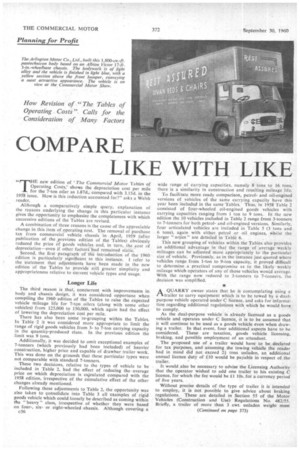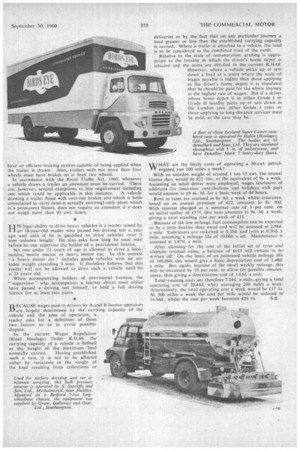COMPARE LIKE WITH LIKE
Page 140

Page 143

If you've noticed an error in this article please click here to report it so we can fix it.
if HE new edition of 'The Commercial Motor Tables of
Operating Costs,' shows the depreciation cost per mile for the 7-ton oiler as I.87d., compared with 3.15d. in the 1958 issue. How is this reduction accounted for?" asks a Welsh reader.
Although a comparatively simple query, explanation of the reasons underlying the change in this particular instance gives the opportunity to emphasize the completeness with which successive editions of the Tables are revised.
A combination of three reasons is the cause of the appreciable change in this item of .operating cost. The removal of purchase tax from commercial vehicle chassis in• April, 1959 (after publication of the ,previous edition of the Tables) obviously reduced the price of goods vehicles and, in turn, the cost of depreciation—even if other factori had remained static.
Second, the firstparagraph of theintroduction of the 1960 edition is particularly significant in this instance. I refer to the statement that adjustments have been made in the new edition of the Tables to provide still greater simplicity and appropriateness relative to current vehicle types and usage.
Longer Life
The third reason is that, concurrent with improvements in body and chassis design, it was considered opportune when compiling the 1960 edition of the Tables to raise the expected vehicle mileage life for 7-ton oilers (along with some other vehicles) from 125,000 to 150,000, which again had the effect of lowering the depreciation cost per mile.
There has also been some re-grouping within the Tables. In Table -2 it was considered more appropriate to limit the range of rigid goods vehicles from 3to 7-ton carrying capacity in the quantity-produced class. In the previous edition the limit was 9 tons.
Additionally, it was decided to omit exceptional examples of 7-tormers (which previously had been included) of heavier construction, higher price and capable of drawbar trailer work. This was done on the grounds that these particular types were not comparable with standard 7-tormers.
These two decisions, relative to the types of vehicle to be included in Table 2, had the effect of reducing the average price on which depreciation is calculated compared with the 1958 edition, irrespective of the cumulative effect of the other changes already mentioned.
Following these adjustments to Table 2, the opportunity was also taken to consolidate into Table 3 all examples of rigid goods vehicle which could loosely be described as coming within the " heavy " class, irrespective of whether they were based on four-, sixor eight-wheeled chassis. Although covering a c56 wide range of carrying capacities, namely 8 tons to 16 tons, there is a similarity in construction and resulting mileage life.
To facilitate more ready comparison, petroland oil-engined versions of vehicles of the same carrying capacity have this year been included in the same-Tables. Thus. in 1958 Table 2 consisted of four-wheeled oil-engined goods vehicles with carrying capacities ranging from 1 ton to 9 tons. In the new edition the 10 vehicles included in Table 2 range from 3-tonners to 7-tonners for both petroland oil-engined versions. Similarly, four articulated vehicles are included in Table 5 (3 tons and 6 tons), again with either. petrol or oil engines, Whilst the larger " artics" are detailed in Table 6.
This new grouping of vehicles within the Tables also provides an additional advantage in that the range of average weekly mileages can be adjusted more appropriately to the particular size of vehicle. Previously, as in the instance just quoted where vehicles range from 1-ton to 9-ton capacity, it proved difficult to determine a practical compromise as to the likely weekly mileage which operators of any of those vehicles would average. With the range now reduced to 3-tonners to 7-tonners, the decision was simplified.
AQUARRY owner states that he is contemplating using a trailer to carry equipment which is to be towed by a duall purpose vehicle operated under C licence, and asks for informstion regarding additional regulations with which he would have to comply.
As the dual-purpose vehicle is already licensed as a goods vehicle and operates under C licence, it is to be assumed that it will continue to be used as a goods vehicle even when drawing a trailer. In that event, four additional aspects have to he considered. These are taxation, goods vehicle licensing, braking, and possible employment of an attendant.
The proposed use of a trailer would have to be declared for tax purposes, and assuming the towing vehicle the reader had in mind did not exceed 21 tons unladen, an additional annual licence duty of flO would be payable in respect of the trailer.
It would also be necessary to advise the Licensing Authority that the operator wished to add one trailer to his existing C licence, for which the fee would be 11 10s. for a currency period of five years.
Without precise details of the type of trailer it is intended to employ, it is not possible to give advice about braking regulations. These are detailed in Section 55 of the Motor Vehicles (Construction and Use) Regulations No. 482/55. Briefly, a trailer of more than 3 cwt. unladen weight must have an efficient braking system capable of being applied when the trailer is drawn. Also, trailers with not more than four wheels must have brakes on at least two wheels.. .
In accordance with the Road Traffic Act, 1960, whenever a vehicle draws a trailer an attendant must be carried.. There are, however, several exceptions to this requirement including one which could be applicable in this instance. A vehicle drawing a trailer fitted with over-run brakes and which is both constructed to carry (and is actually carrying) only plant which is a permanent fixture, does not require an attendant if it does not weigh more than 45 cwt. laden.
HIS legal ability to drive heavy vehicles is a matter raised by an 18-year-old reader who passed his driving test a year ago and asks if he is qualified tovehicles over 3 tons unladen weight. He also asks ow long he must wait before he can supervise the holder of a provisional licence.
No one under 21 years of age is allowed to drive a locomotive, motor tractor or heavy motor car. In this context a heavy motor car" includes goods vehicles with an unladen weight exceeding 3 tons. It therefore follows that this reader will not be allowed to drive such a vehicle until he is. 21 years old.
When accompanying holders of provisional licences, the " supervisor " who accompanies a learner driver must either have passed a driving test himself, or held a full driving licence for at least two years.
ECAUSE wages paid to drivers by A and B licence operators
are largely determined by the carrying capacity of the vehicle and the area of operation, a reader asks for a definition of these two factors so as to avoid possible dispute.
in the current Wages Regulation (Road Haulage) Order R.1-1.68, the carrying capacity of a vehicle is defined as the weight of the maximum load normally carried. Having established such a rate, it is not to be affected either by variations in the weight of the load resulting from collections or deliveries or by the fact that on any particular journey a load greater or less than the established carrying capacity is carried. Where a trailer is attached to a vehicle, the load is to be considered as the combined load of the outfit.
Relative to the scale of remuneration, grading is appropriate to the locality in which the driver's home depot is situated and the areas are detailed in the current R.H.68. However, where a vehicle picks up or sets down a load at a point where the scale of wages payable is higher than those applying to the driver's home depot, it is stipulated that he should be paid for the whole journey at the highest rate of wages. But if a driver whose home depot is in either Grade I Or Grade II locality picks up or sets down in the London area either Grade I rates or those applying to long-distance services must be paid, as the case may be.
WVWHAT are the likely costs of operating a 30-cwt. petrolengined van 200 miles a week? With an unladen weight of around 1 ton 15 cwt. the annual licence duty would be £22 10s., or the equivalent of 9s. a week. Assuming an adult driver were employed, wages (inclusive of additions for insurance contributions and holidays with pay) would amount to £9 4s. 3d. for a basic week of 44 hours.
Rent or rates are assessed at 8s. 8d. a week whilst insurance, based on an annual premium of £22, amounts to 8s. 10d. With interest charged at a nominal rate of 3 per cent, on an initial outlay of £775, this item amounts to 9s. 3d. a week, giving a total standing cost per week of £11.
Because of the low mileage, fuel consumption can be expected to be a .little heavier than usual and will be assessed at 2.98d. a mile. Lubricants are reckoned at 0.20d. and tyres at 0.56d. a mile, assuming a mileage life of 30,000 a set. Maintenance is assessed at 1.87d. a mile.
After allowing for the cost of the initial set of tyres and ultimate residual value, a balance of £615 will remain to be written 'off. On the basis of an estimated vehicle mileage life of 100.000, this would give a basic depreciation cost of 1.48d. a mile. But, again. because of the small weekly mileage, this will he increased by 10 per cent. to allow for possible obsolescence, thus giving a depreciation cost of 1.63d. a mile.
Total running costs are therefore 7.24d. a mile, giving a total operating cost of 20.44d. when averaging 200 mites a week. Alternatively, the total operating cost a week would be £17 Is. At 300 miles a week the cost per mile would be reduced to 16.04d., whilst the cost per week becomes £20 Is. S.B.
























































































































































































